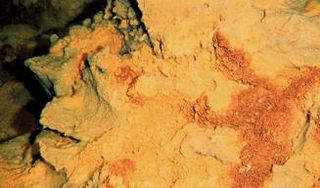The Aquificota phylum is a diverse collection of bacteria that live in harsh environmental settings. The name Aquificota was given to this phylum based on an early genus identified within this group, Aquifex, which is able to produce water by oxidizing hydrogen. They have been found in springs, pools, and oceans. They are autotrophs, and are the primary carbon fixers in their environments. These bacteria are Gram-negative, non-spore-forming rods. They are true bacteria as opposed to the other inhabitants of extreme environments, the Archaea.
The Thermomicrobia is a group of thermophilic green non-sulfur bacteria. Based on species Thermomicrobium roseum and Sphaerobacter thermophilus, this bacteria class has the following description:
The Aurantimonadaceae are a small family of marine bacteria.
Aurantimonas is a genus of bacteria from the family of Aurantimonadaceae.
The oxidase test is used to determine whether an organism possesses the cytochrome c oxidase enzyme. The test is used as an aid for the differentiation of Neisseria, Moraxella, Campylobacter and Pasteurella species. It is also used to differentiate pseudomonads from related species.

Campylobacterota are a phylum of Gram-negative bacteria. Only a few genera have been characterized, including the curved to spirilloid Wolinella, Helicobacter, and Campylobacter. Until the 2021 revision of bacterial taxonomy by the ICSP, the entire phylum was classified within the Proteobacteria as the Epsilonproteobacteria.

Gammaproteobacteria is a class of bacteria in the phylum Pseudomonadota. It contains about 250 genera, which makes it the most genus-rich taxon of the Prokaryotes. Several medically, ecologically, and scientifically important groups of bacteria belong to this class. All members of this class are Gram-negative. It is the most phylogenetically and physiologically diverse class of the Pseudomonadota.

In taxonomy, Cenarchaeum is a genus of the Cenarchaeaceae. The marine archaean Cenarchaeum symbiosum was initially detected as a major symbiotic microorganism living within the sponge Axinella mexicana. It has been ubiquitously detected in the world oceans at lower abundances, while in some genera of marine sponges it is one of the most abundant microbiome members. Its genome sequence and diversity has been investigated in detail finding unique metabolic products and its role in ammonia-oxidizing activities.

The genus Lysobacter belongs to the family Xanthomonadaceae within the Gammaproteobacteria and includes at least 46 named species, including: Lysobacter enzymogenes, L. antibioticus, L. gummosus, L. brunescens, L. defluvii, L. niabensis, L. niastensis, L. daejeonensis, L. yangpyeongensis, L. koreensis, L. concretionis, L. spongiicola, and L. capsici. Lysobacter spp. were originally grouped with myxobacteria because they shared the distinctive trait of gliding motility, but they uniquely display a number of traits that distinguish them from other taxonomically and ecologically related microbes including high genomic G+C content and the lack of flagella. The feature of gliding motility alone has piqued the interest of many, since the role of gliding bacteria in soil ecology is poorly understood. In addition, while a number of different mechanisms have been proposed for gliding motility among a wide range of bacterial species, the genetic mechanism in Lysobacter remains unknown. Members of the Lysobacter group have gained broad interest for production of extracellular enzymes. The group is also regarded as a rich source for production of novel antibiotics, such as β-lactams containing substituted side chains, macrocyclic lactams and macrocyclic peptide or depsipeptide antibiotics like the katanosins.
Alicyclobacillus is a genus of Gram-variable, rod-shaped, spore-forming bacteria. The bacteria are able to grow in acidic conditions, while the spores are able to survive typical pasteurization procedures.
Nitrospirota is a phylum of bacteria. It includes multiple genera, such as Nitrospira, the largest. The first member of this phylum, Nitrospira marina, was discovered in 1985. The second member, Nitrospira moscoviensis, was discovered in 1995.

The class Zetaproteobacteria is the sixth and most recently described class of the Pseudomonadota. Zetaproteobacteria can also refer to the group of organisms assigned to this class. The Zetaproteobacteria were originally represented by a single described species, Mariprofundus ferrooxydans, which is an iron-oxidizing neutrophilic chemolithoautotroph originally isolated from Kamaʻehuakanaloa Seamount in 1996 (post-eruption). Molecular cloning techniques focusing on the small subunit ribosomal RNA gene have also been used to identify a more diverse majority of the Zetaproteobacteria that have as yet been unculturable.
Aurantimonas coralicida is a gram-negative bacterium, and a causative agent of white plague in Caribbean corals. It is rod-shaped, with polar flagella.
Aureimonas altamirensis is a Gram-negative, catalase- and oxidase-positive, non-motile bacteria from the genus Aurantimonas which was isolated from Altamira Cave in Cantabria in Spain. Aurantimonas altamirensis was reclassified to Aureimonas altamirensis.
Aurantimonas litoralis is a Gram-negative, catalase- and oxidase-positive, non-motile bacteria from the genus of Aurantimonas which was isolated from coastal water from Oregon in the United States.
Aureimonas frigidaquae is a Gram-negative, catalase- and oxidase-positive, facultatively anaerobic bacteria from the genus of Aurantimonas which was isolated from a water-cooling system in Gwangyang in the Republic of Korea. Aurantimonas frigidaquae was reclassified to Aureimonas frigidaquae.
Aureimonas jatrophae is a bacterium from the genus of Aurantimonas which was isolated from the plant Jatropha curcas Linnaeus in the Agrotechnology Experimental Station of Lim Chu Kang in Singapore.
Aureimonas phyllosphaerae is a bacterium from the genus of Aurantimonas which was isolated from the plant Jatropha curcas Linnaeus from an agrotechnology experimental station in Lim Chu Kang in Singapore.
Aureimonas rubiginis is a bacterium from the genus of Aurantimonas which was isolated from a rusty iron plate.
Aureimonas glaciei is a Gram-negative, aerobic, short rod-shaped and motile bacteria from the genus of Aurantimonas which has been isolated from the Muztagh Glacier in China.




